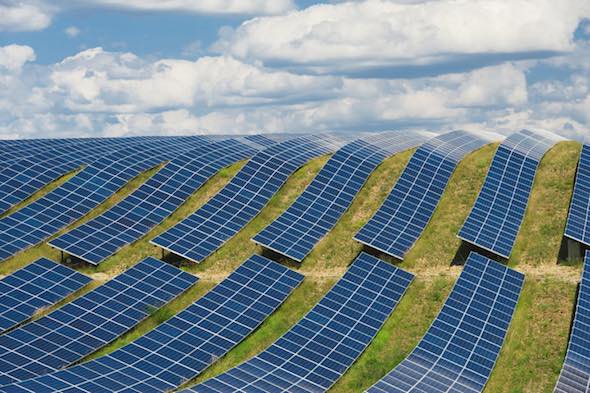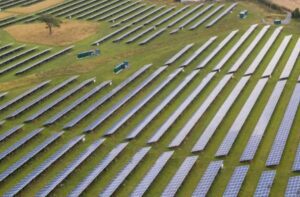
UK billionaire Sanjeev Gupta is a very rich man, with a very big business that consumes a lot of energy.
In the last few months he has come to the same conclusion as tens of thousands of Australian homeowners and thousands of businesses, big and small: the best way to cut your bill for energy is to generate your own.
Gupta this week unveiled the details of his plans to build 1 gigawatt of large-scale solar, battery storage, pumped hydro and demand management for the Whyalla steel works and other big energy users in South Australia.
Gupta reckons it will slash his company’s energy bills by around 40 per cent, and he intends to repeat the dose in his even bigger steel plants in Melbourne and Sydney, which he says will be powered 100 per cent by renewable energy within a few years.
Most businesses reckon they can achieve similar savings, which is why the likes of Nectar Farms are turning to wind and battery storage for a $750 million investment in a new glass house and energy park near Stawell in Victoria, and why zinc refiner Zinc Metals is turning to solar to slash the costs of electricity in north Queensland and, like Gupta, help to expand the business.
It’s why Telstra has contracted to take the output of a 72MW solar farm in Queensland, and will do the same with many more such facilities; it’s why Foster’s Brewing is going 100 per cent renewables; why Woolworths is also turning to solar, along with countless other large retailers, and mining groups.
Households can do even better. The pay-back for a rooftop solar system is probably less than five years – for an asset that will last 25 years. The savings on an electricity bill, even without the generous “premium” tariffs that too many still enjoy, are well over 50 per cent.
As Gupta says, and nearly two million household and businesses understand, it’s not a difficult equation. The cost of solar has plunged 90 per cent in the last five years, and the cost of storage is following suit.
The cost of grid power, on the other hand, has more than doubled.
Australia has ridiculously high charges for electricity from the grid. For many consumers, it’s around 40c/kWh or even more, and that’s around 50 per cent more than the cost of a diesel generator in the outback.
It’s absurd, and it’s got little to do with the cost of technologies or the cost of service.
It’s more about the greed of the incumbents, the monopoly that own the networks, and the oligopolies that control the wholesale markets and dominate the retail scene, and the totally inadequate supervision by the regulators.
Amid all this, and with the opportunities that abound in Australia with its resources in solar, wind, know-how and smart software, and the opportunity for a major reduction in emissions, what does the consumer get from the politicians and some of the principal regulators?
Nonsense. Complete and utter nonsense.
The Coalition wages a war against renewables that is based on wild myths, ignorance and prejudice perpetuated by obscure blogs and disgruntled right-wingers.
State and federal pricing regulators wring their hands, tut-tutting about the prevalence of solar, anxious to protect the revenues of the their lunch guests, when most studies suggest the benefits of rooftop solar far outweigh the costs.
More recently, and most disappointingly, the best the newly formed Energy Security Board could produce – when instructed to produce a “policy” that the right wing in the Coalition could accommodate – was a plan for a plan that would not meet emissions targets, and could stop renewable energy in its tracks.
More crucially, it offers little or no savings to consumers. Maybe $2 a week, maybe 50c, but quite possibly nothing at all. The overwhelming consensus of independent analysts is that it is more likely to push prices higher.
Really, who are they trying to kid?
Much has been written about the National Energy Guarantee, and much more will be, particularly when we actually get a few more details.
The kind view of the NEG is that the idea of introducing a reliability and an emissions guarantee into the wholesale energy market might possibly work. And that the ESB should be forgiven their forecasts because they had a moment’s notice to come up with a plan, and realpolitik to deal with.
The idea that it might just work comes with one important caveat: only if it is in the right hands – in the hands of people who understood that technology is changing, and want to facilitate and accelerate that change, so that more consumers and businesses can also benefit.
In the wrong hands, this plan could prove disastrous. Rather than accelerating the transition to clean energy, it could seek to stall it – and that would be for the benefit of no one apart from the interests of the incumbent businesses and the satisfaction of certain ideologues.
We don’t know yet whether that is the case. But the modelling produced so far by the ESB – prepared for them by the backward looking Australian Energy Market Commission – gives little reason for confidence.
Just saw Frontier’s NEG modelling assumptions. As usual solar PV & wind costs in 2030 are higher than market today. Backending here we come
— Tristan Edis (@TristanEdis) November 1, 2017
The next round of modelling – by Frontier Economics – looks set to repeat the dose of inflated costs of wind and solar that has marked their previous work for the AEMC in its various campaigns against renewables.
Every single study that was ever completed into the Australian energy industry agrees on one thing: that more investment and more competition, particularly from renewables, will result in lower costs.
The numbers produced by the ESB – and this is all we have to judge them on – indicate little or no new investment over the decade from 2020-2030. Little wonder they factor in no meaningful reduction in costs, and the very minimum in terms of emission reductions.
Regulators have done energy consumers in Australia no favours in the past decade. To the eyes of economic rationalists, the National Energy Market it is a thing of academic beauty.
But it has been rorted, gamed, manipulated, abused and priced to the point of absurdity and where businesses are now closing and low-income folk are going without food or other necessary items – and those that can are investing in their own solar power and storage.
It’s the result of greedy bastards going unchecked, of inadequate rules, weak supervision, and lousy planning (particularly with forecasts).
This has allowed the monopoly networks to double their charges largely unchecked; the generators to use and abuse their market power to the full; and the retailers to profit by confusing the hell out of consumers.
The degree of regulatory capture – the term used to describe where regulatory agencies, created to act in the public interest, instead choose to advance the commercial or political concerns of special interest groups that dominate the industry or sector – has been complete.
This is the true test of the Energy Security Board. These are smart people. Highly qualified people. But unless they can provide a document and a plan that takes advantage of the technologies and the cost reductions at hand – and seize the imperative of reducing emissions – there really is no point to it.
Perhaps it may have to play a sleight of hand, to convince the conservatives that their clients and their favoured industries are protected, while at the same time allowing for an alternative government to significantly raise the level of ambition. It therefore has to be scalable.
All they have to do is follow the example of Gupta, Sun Metals, Nectar Farms, Foster’s, the big retailers, thousands of smaller businesses and more than a million households.
If they can’t even do that, then they should stop the pretense now. There is an argument that something is better than nothing, but not when that “something” pretty much prevents anything from being achieved.
RenewEconomy has a huge readership from overseas who, for good reason, know that Australia is at the cutting edge of this energy transition: nowhere else in the world do you get such amazing resources, fantastic talent, and the cost leverage presented by the highest grid prices of a developed economy on the planet.
The opportunities for Australia to emerge as a renewable energy powerhouse, with cheap, reliable and clean energy, and a faster, smarter, cheaper and more reliable grid, are enormous.
The alternative is for Australia to be seen increasingly as a crash test dummy for the rest of the world. We keep on driving into walls. We have to learn how to do better.









